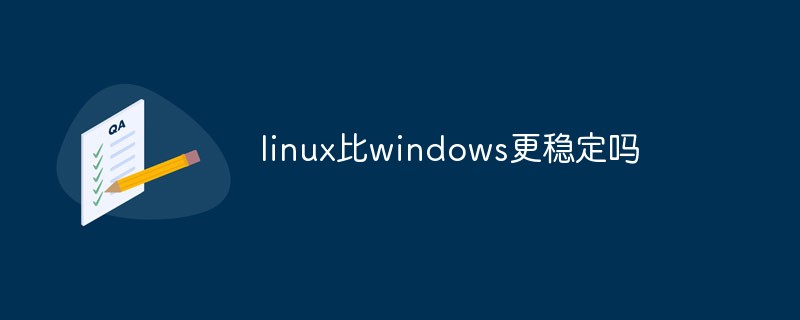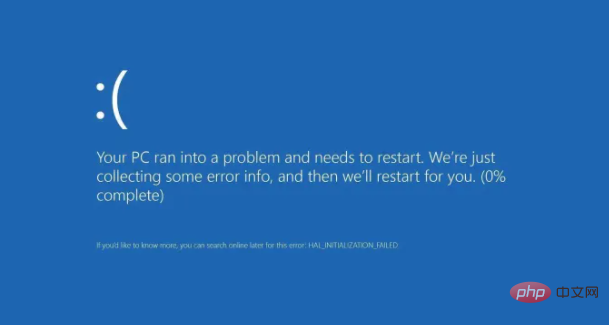
Yes. Reasons: 1. When Win automatically updates the system, it will only upgrade components officially provided by Microsoft, while the Linux automatic update system will upgrade all software in the system (including third-party applications) at the same time; 2. Linux is a multi-user operation System, the underlying system files will always be protected; 3. Modular design, unsafe components can be removed; 4. There are good "zero-day attack" defense tools; 5. Open source code architecture, nothing is hidden Repair measures; 6. Diversified system environment.

#The operating environment of this tutorial: linux7.3 system, Dell G3 computer.
Yes, Linux systems are more stable and secure than Windows systems.
The open source characteristics of Linux allow us to have a certain degree of control over its stability (based on capability considerations) because the behavior is predictable and manageable. As Windows is closed source, there are many uncontrollable factors and unpredictable behaviors.
In addition, from the source code, we can understand that in order to be incorporated into the main line, the Linux source code must conform to the code format and the code level must reach a certain level. Beginners’ water injection codes cannot be absorbed. , leading to performance degradation cannot be absorbed.
Six reasons why Linux is more stable and more secure than Windows
1. More excellent patch management tools:
In Microsoft Windows systems, the automatic update program will only upgrade those components officially provided by Microsoft. Third-party applications will not be patched. Therefore, third-party applications may bring a lot of security risks to your system.

Are you using Real player? You need to upgrade it separately. Using Flash? You still need to upgrade separately. By analogy, for all applications on your computer, you need to update and upgrade each software separately on a regular basis. This method is very tedious and annoying, and most users quickly forget about this task.
In the Linux system, when you automatically update the system, it will upgrade all the software in the system at the same time. In the Ubuntu system, any software product you download will appear in the system's program warehouse. To upgrade it, you only need to click with the mouse. In other Linux distributions, if the downloaded software does not appear in the system's program repository, it is very simple to add it. This design greatly improves users' enthusiasm for updating the system in real time.
2. More robust default settings:
The Linux system is inherently designed to be a multi-user operating system. Therefore, even if a user wants to cause malicious damage, the underlying system files are still protected. If, under very unfortunate circumstances, any remote malicious code is executed in the system, the harm it brings will be limited to a small local area.
In sharp contrast is Microsoft's Windows XP system. Here, users will log in as system administrators by default, and any damage that occurs in the system will quickly spread to the entire system. Microsoft's latest Windows Vista system lets users log in as restricted users by default, so it's a little more secure than its predecessor.
3. Modular design:
The Linux system adopts a modular design. This means that you can remove any system component if it is no longer needed. One benefit that comes from this is that if the user feels that a certain part of the Linux system is not safe, he can remove this component.
This is simply incredible for Windows systems. For example, if I feel that the Firefox web browser is the weakest link in my Linux system, I can completely delete it and replace it with another web browser, such as Opera. In the Windows system, no matter how dissatisfied I am, I cannot replace Microsoft's Internet Explorer web browser.
4. Better "zero-day attacks" defense tools
Even if you can ensure that your system is updated in real time, this does not mean It means foolproof! Zero-day attacks (zero-day attacks, which refer to attacks that exploit vulnerabilities to launch network attacks before software manufacturers release updated patches for vulnerabilities) are becoming increasingly rampant. In addition, a survey study also showed that it only takes 6 days for attackers to develop malicious attack code for vulnerabilities, while software manufacturers take much longer to launch corresponding Update patch. Therefore, a smart security strategy is crucial in protecting against zero-day attacks. Microsoft's Windows XP system does not provide such a defense mechanism. The new Vista system, in the protected mode state, although it has a certain effect, can only provide some limited protection against attacks against the Internet Explorer web browser.
Correspondingly, no matter what type of remote control code attack it is, AppArmor or SELinux can provide detailed and comprehensive protection for the system. There are more and more mainstream Linux distributions that integrate AppArmor (for example, SuSE, Ubuntu Gutsy) or SELinux (Fedora, Debian Etch, Yellow Dog) by default in the system. Even for other distributions, users can easily download and install these two sets of software from the Internet
5. Open source code architecture:
In Linux systems, when talking about system security, the phrase "what you see is what you get" is more appropriate. Open source means that any possible software vulnerabilities will be seen by "countless pairs of eyes" and fixed as quickly as possible. And more importantly, this also means that there are no hidden fixes here. As a user, as long as you are willing, you can find out the security problems in your system and take corresponding preventive measures to deal with potential security threats, even if the vulnerability has not been patched at this time.
In the Windows world, many security issues are covered up. Software vulnerabilities discovered within Microsoft will not be known to the outside world, and all they want is to silently patch them in the next update and upgrade package. Although this can reduce the number of software vulnerabilities that are disclosed and prevent certain vulnerabilities from being exploited on a large scale, it also blinds users. The result of this is that the user is likely not to actively upgrade the system because he does not understand what kind of vulnerabilities exist in his system and the harm caused by these vulnerabilities. Instead, he will become a victim of malicious attacks.
6. Diversified system environment:
The system environment of Windows can be said to be the same. This huge consistency makes it easy for attackers to write malicious code, viruses, or whatnot. In turn, take a look at the world of Linux systems. Here, the application can be .deb, .rpm, or source code, and so on. This difference makes it difficult for attackers to gain as wide an impact on Linux systems as on Windows systems.
Finally, but most importantly, you must always remember that the security of the system is ultimately in the hands of the user. An experienced user can safely use the Windows 98 operating system, while an ignorant user can make an OpenBSD-based system riddled with holes. Therefore, in the final analysis, talent is the core of system security, and talent is the foundation of everything. Keep this in mind!
Related recommendations: "Linux Video Tutorial"
The above is the detailed content of Is linux more stable than windows?. For more information, please follow other related articles on the PHP Chinese website!